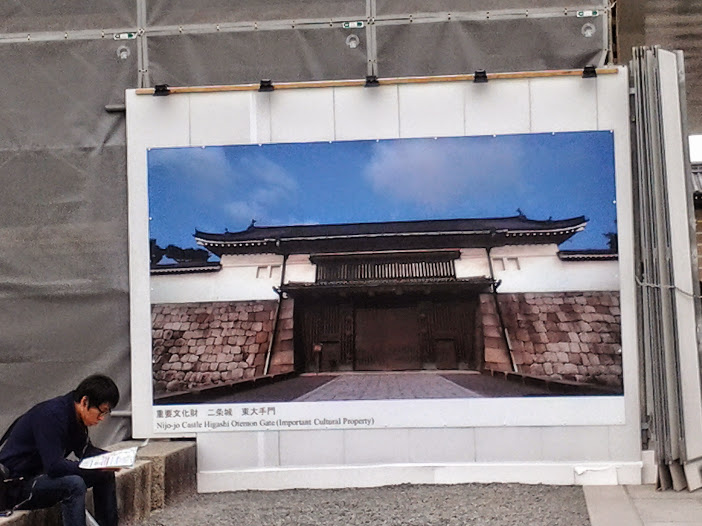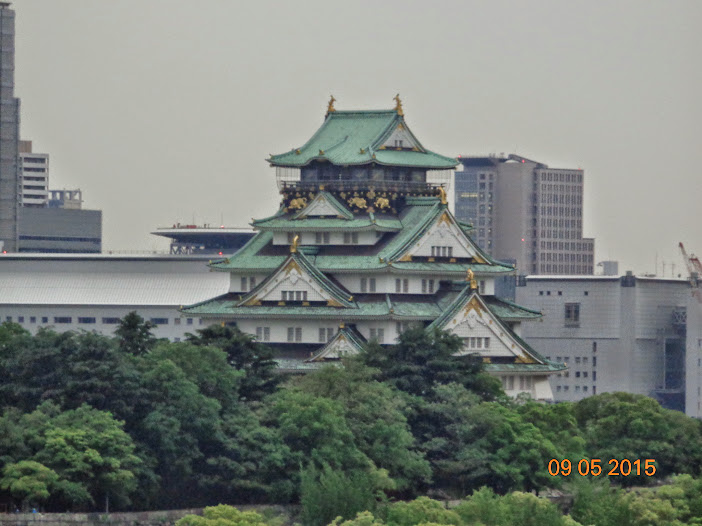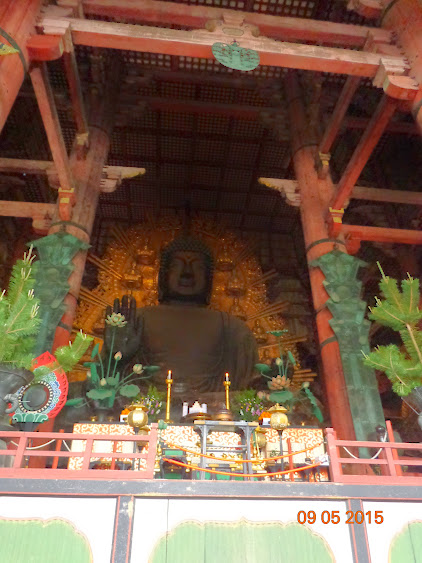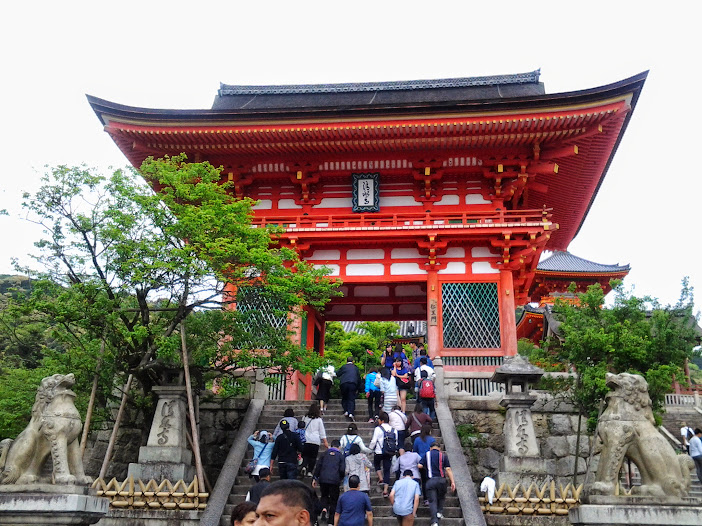DAY TWO - 09 May 2015. - OSAKA - NARA - KOYOTO - OSAKA.
Those who have gone on group travels will know how the system works . Generally one reaches a destination by evening or early night , it is therefore not possible to do anything other than go to the room and call it a day. This is also the time the tour manager gives you three timings for the next day's programme , one ,time for wake up call , two , time for breakfast and three , time to get in the coach for the journey and sightseeing for the day. Generally these timings are 0630 h wakeup,0730 h breakfast ,and 8030 h coach for departure.
However we being early riser were always ready much before the wakeup call . During all our travels this the time getting up & till breakfast I use for photos session. During this session I shoot , views from the room , hotel interiors , hotel surroundings etc. In group travels at times you are lucky and get room with good view . In Osaka we stayed in Hotel New Otani and stayed in Room 1437 .We lucky here as we had very good view from our room . As said , being early for breakfast I tried to get as many photos as possible of the room views , hotel interiors and hotel surroundings . Here are photos from before breakfast time photo session at Hotel New Otani,
Panoramic view of Osaka from our room ,
Hotel New Otani.
Osaka Castle . Photo using 4x Zoom .
The castle is one of Japan's most famous landmarks and it played a major role in the unification of Japan during the sixteenth century of the Azuchi-Momoyama period.
view from the room
Osaka Jo Hall with Osaka Castle in the background . Osaka-jō Hall is a multi-purpose arena,The hall opened in 1983 and can seat up to 16,000 people.
View from our room .
Dining Hall . Hotel . New Otani
Reception , Hotel New Otani .
The Lobby , Hotel New Otani .
The Lobby , Hotel New Otani .
With breakfast over ready to depart for sightseeing of the day.
As per the itinerary we were supposed to go by road to Nara ,Kyoto and return back to
Osaka Hotel for the night . At that time on 09 May 2015 , I did not know anything about Nara and Kyoto . What follows hereafter is the result of googling around for writing this blog . I hope that this effort will be of use to those who intend to go visiting Nara and Kyoto.
Nara is approx 32 kms due East from Osaka . It is the capital of Nara Prefecture ( Japanese Prefecture is equivalent to our , Tehsil , District or State take your pick ) . It has a long history stretching back thousands of years . It was the capital of Japan in one form or the other since 694 to 784 . It was very prosperous and powerful city . Large number of Buddhist temples were built and Buddhist Monks yielded tremendous power and influenced government decisions.
Nara Prefecture has the distinction of having more UNESCO World Heritage Listings than any other prefecture in Japan . Nara encompasses eight places in the old capital Nara . Five are Buddhist temples, one is a Shinto shrine, one is a Palace and one a primeval forest. The properties include 26 buildings designated by the Japanese Government as National Treasures as well as 53 designated as Important Cultural Properties. All compounds have been recognized as Historic Sites. Tōdai-ji, Kōfuku-ji and the Kasugayama Primeval Forest overlap with Nara Park, a Place of Scenic Beauty. UNESCO listed the site as World Heritage in 1998. All the monuments were either destroyed by an earthquake or more often than not by fire, and were rebuilt again after every destruction . The is universally true for almost all the historic monuments throughout Japan
Kyoto.
Kyoto is 43 kms due North from Nara.Kyoto also has a long history and was also capital of Japan in the 11th centuary. Important city then & even now.The UNESCO World Heritage Site Historic Monuments of Ancient Kyoto encompasses 17 locations within the city of Kyoto and its immediate vicinity. The locations are in three cities: Kyoto and Uji in Kyoto Prefecture; and Ōtsu in Shiga Prefecture; Uji and Ōtsu border Kyoto to the south and north, respectively. Of the monuments, 13 are Buddhist temples; three are Shinto shrines; and one is a castle. The properties include 38 buildings designated by the Japanese government as National Treasures, 160 properties designated as Important Cultural Properties, eight gardens designated as Special Places of Scenic Beauty, and four designated as Places of Scenic Beauty. UNESCO listed the site as World Heritage in 1994. All the monuments were either destroyed by an earthquake or more often than not by fire, and were rebuilt again after every destruction . The is universally true for almost all the historic monuments throughout Japan .
Of all these heritage sites in Nara and Kyoto we missed most of them and at Nara we passed through Nara Deer Park and saw only Tōdai-ji Temple. At Kyoto only Kinkaku-ji , Nijō Castle , and Kiyomizu-dera were seen by us .
This is a major minus point of Group Tours with any travel agency . On the other hand Air Travel , Accommodation , Transportation throughout the tour , Eating places , payment of entry fees etc are all taken care of . All one has to do is follow the Tour Manager .
It is entirely an individual's choice to go on tailor made tours or through a travel agency.
Nara passing through Deer Park and Visit to Tōdai-ji Temple .
Coach Parking near Nara Deer Park .
Passing through Deer Park .
Nandai-mon Gate : The Great South Gate of Todai-ji Temple in the background.
Nandai-mon Gate : The Great South Gate . Todai-ji Temple. The Gate has been declared a National Treasure . It was built in 13th century .
Equivalent to great statues of " Dwarpals" , in our temples in South India . This is one of the two in the Main South Gate ( Nandoi-mon). Traditionally One of these Dwarpals is always with mouth open ( Agyo ) and the other with mouth closed
( Ungyo ). This Agyo within The main South Gate, was created by Unkei, Kaikei, and other sculptors in 1203 .
This Ungyo opposite Agyo Statue within The main South Gate, was also created by Unkei, Kaikei, and other sculptors in 1203 .
Todai ji temple.The Great Buddha Hall.
Another view ,The Great Buddha Hall.
Todai ji temple
The bronze Octagonal Lantern, one of the oldest treasures in Todaiji — it dates from the original 8th-century temple. The lantern's support post is inscribed with a Buddhist text on the merits of lighting lanterns.
The Great Buddha of Todai-Ji Temple.
The Great Buddha of Todai-Ji Temple was completed after after 38 years of construction. It is one of the three great Buddha portrait statues in Japan.
Measurements:
- Height of Statue: 13.7 metres (44.9 ft)
- Length of Face: 3.63 metres (11.9 ft)
- Length of Eyes: 0.66 metres (2.2 ft)
- Length of Ears: 2.12 metres (7.0 ft)
- Width of Mouth: 1.31 metres (4.3 ft)
- Height of Nose: 0.36 metres (1.2 ft)
Scale model of Todai-Ji as it was constructed originally .
Model based on old manuscripts and documents.
Located in Main Hall of temple.
The original complex also contained two 100 m pagodas, perhaps second only to the pyramids of Egypt in height at the time. These were destroyed by an earthquake.
Located in Main Hall of temple.
The original complex also contained two 100 m pagodas, perhaps second only to the pyramids of Egypt in height at the time. These were destroyed by an earthquake.
More photos and information included in the album for DAY TWO .
After going around Todai-Ji Temple we proceeded to Kyoto.
First place in Kyoto was Kinkaku-ji temple.
So-mon gate of Kinkaku-ji temple. The path after this leads to the Kara-mon gate(Chinese-style gate).Kinkaku-
ji Temple
Shoro Bell Tower. Kinkaku-ji Temple
Golden Pavilion .
Kinkaku-ji "Temple of the Golden Pavilion", officially named Rokuon-ji "Deer Garden Temple".
Kinkaku-ji "Temple of the Golden Pavilion", officially named Rokuon-ji "Deer Garden Temple".
Phonenix on the rooftop of Golden Pavilion , Kinkaku.
Reflection Pond , Kinkou Ji
Golden Pavilion and its reflection in the reflection pond . Looks really beautiful and taking a photo of reflection of Golden Pavilion in the reflecting Pond is considered a MUST :-).
By the time we had gone around the rest of the premise of Kinkau Ji Temple it was approaching lunch time . Proceeded to Namaste Taj Restaurant , Kyoto for lunch.
Higashiote-mon (Main Gate) of Nijō Castle.
This is " photo" of the gate , real gate was under repairs and covered :-)
The roof is constructed of tiles in hip-and-gable fashion, with gables of latticework, and the ridge of the roof is adorned with Shachihoko (a traditional dolphin-like fish).
Namaste Taj Restaurant , Kyoto
After lunch it was time to continue with sightseeing . Proceeded to Nijō Castle ,
 |
Higashiote-mon (Main Gate) of Nijō Castle.
This is " photo" of the gate , real gate was under repairs and covered :-)
The roof is constructed of tiles in hip-and-gable fashion, with gables of latticework, and the ridge of the roof is adorned with Shachihoko (a traditional dolphin-like fish).
The Karamon entrance gate of Nijo-jo in Kyoto
Details on The Karamon entrance gate of Nijo-jo in Kyoto
Entrance gate , Ninomaru Palace . There are no more photos of this place .
Not many photos of Nijo Castle and Palace . Quite a few audience halls and most of the building were in the process of restoration / renovation . May be because of this or other wise photography was prohibited in all buildings . So only limited number of photos could be taken in Nijo Castle and Palace .
Proceeded to Kiyomizu Dera , next sight for sight seeing on the itinerary .
Located halfway up Otowa Mountain in the eastern part of Kyoto City, Kiyomizu-dera is a
historic temple that was established in 778, even before Kyoto became the capital of Japan. Literal meaning of Kiyomizu Dera is " Pure water Temple " and is derived from Otowa Falls which is a perennial clear water fall .
As per web site http://www.kiyomizudera.or.jp/lang/01.html principle image ( "deity "? ) is eleven headed and Thousand Armed Kannon Bodhisattva, In Japanese Kannon means " God " or " Goddess " of Mercy . This may be reason why at places it says that "Kiyomizu Dera is the temple of the Goddess of Mercy,"
Even though the Temple is situated half way up the mountain , all the parking lots are at the foot hill about a km away from the temple gate , the km approach roads pass through narrow lanes with shop lined on both side , selling all kinds of things from trinkets , mementos to , toys and food stuff as well.The shops do roaring business . A thought comes to mind whether the distance of parking lots and approach road through the shopping street is by design or happened just naturally . You see the present arrangement does give tremendous boost to commerce and local economy :-)
View of approach road to the temple through the shopping street .
Another view of approach road to the temple or also view of Matsubara Dori which is Japanese name for the street leading to Kiyomizu-dera .
The Deva gate Kiyomizu Dera.
Sai-mon Gate ( West Gate ) Kiyomizu-dera Temple . Spire and roof of Three Story Pagoda is visible behind the Seimon West Gate .
Three-story pagoda at Kiyomizu-dera, a Buddhist temple in Kyoto, Japan.
Sanju-no-to (Three Storied Pagaoda), the tallest three-storied pagoda in Japan. A little under 31 mtrs.
Rebuilt in 1633 and repainted in 1987 in the original vermilion, the pagoda stands out against the dull brown of the other buildings. The bright color is typical of Buddhist temples, reflecting the Chinese architectural styles that came to Japan together with Buddhism.Mace and Iron shoes of Monk Benkei . Kiyomizu Dera Temple. Visitors try their strength in lifting The Mace / Staff and are unable to even budge it .
For details about Monk Benkei see this photo in album.
Hondo, the Main Hall, of Kiyomizu-dera amid lush Green leaves. The surrounding colours and the scenery change four time in a year , that is , with every season there is a different colour.
The hall was rebuilt in 1633 by the order of the third Tokugawa Shogun Iemitsu. This is a national treasure.. Kiyomizu Dera Temple.
Even though the temple is located half way up the mountain , all the Parking lots are at the foothillvvvvvvvvVVV iew of approach road just about a km from the temple and that km road passes through narrow lane lined with hustling bustling market with all sorts of shops doing roaring business . One wonders if the distance of parking from temple is by design to improve the economy of that small village . Like Something akin to locating food and beverage shops right next to staircase in multi storied Malls.
Supporting structure of Kiyomizu-dera's Main Hall and stage. It is constructed with 139 pillars and no nails are used.The stage Offers beautiful view of Kyoto Town.
For more details see this photo in the album.
Beautiful view of Kyoto City from stage of The Great Hall Kiyomizu Dera Temple.
Another view of Kyoto City .
Don't miss the Beautiful and scenic , colourful and thick foliage on the slopes of the hill.
Otowa Waterfall,
Last important landmark to be seen was Otowa Waterfall.Here visitors can drink the sacred Otowa water , supposed to fulfill a wish, from a ladle . Kiyomizu Dera Temple is named after this waterfall which means " Pure water Temple "
Very well developed roads systems of Japan. On the way for dinner, day two .
Dinner at Mayur Restaurant , Kyoto on day two .
Night view of Osaka Castle .
Back in our hotel room . A well lit Osaka Castle looked very nice and beautiful . Decided to make it last photo of the day .
Tomorrow we check out of New Otani Hotel and proceed to Hiroshima.
Here is the link for photo album of China- Japan Trip : Japan: DAY TWO.
https://plus.google.com/u/0/photos/100798393236899222624/albums/6174118120560165841
Please Do read the captions and info given in the comment column of photos.
Also check out mapped position . If you are interested you may even see the street view of the photo.I hope it will be an interesting experience :-)








































